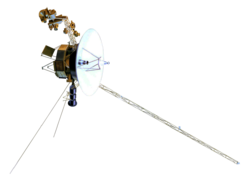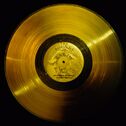Astronomy:Voyager 3
The Voyager 3 was a space probe created by NASA sometime throughout the 1970s. It was originally intended to head to Jupiter, Saturn, and possibly Uranus and Neptune before finally to interstellar space. This trip was cancelled.
History
When Voyager 1 and Voyager 2 were being built, Voyager 3 was in construction as well. The Voyager program was originally intended as a triple spacecraft mission, sending spacecraft to all 4 outer planets. The Voyager 3 spacecraft began construction during the construction of the other Voyager probes. It would’ve been the same model as the other probes.
Prior to the launches of Voyager 1 and 2, the original Voyager 2 showed mechanical problems and had to be replaced by a "spare" probe originally designated Voyager 3 but redesignated Voyager 2; the original Voyager 2 was subsequently repaired and took flight as Voyager 1.[1]
Cancellation
During the construction of Voyager 3, scientists began to discover flaws in Voyager 3’s system, and later cancelled the project because of concerns about the probe failing. It may have been cancelled due to the fact that NASA spent a lot of money during their moon missions from 1969 to 1972 .[2][unreliable source?]
The project of building Voyager 3 was cancelled due to technical issues in the probes instruments, which later lead to NASA workers putting the extra parts of the system in the Voyager 1 and 2 spacecraft.
Golden record
Voyager 3’s Golden Record was originally made, although due to the cancellation of the probe, it has become one of the 6 copies of the record in the world.[3]
File:Voyager Golden Record greeting in English.ogg
Voyager 3 would’ve carried a gold-plated audio-visual disc.[4] The disc carries photos of the Earth and its lifeforms, a range of scientific information, spoken greetings from people such as the Secretary-General of the United Nations and the President of the United States and a medley, "Sounds of Earth", that includes the sounds of whales, a baby crying, waves breaking on a shore, and a collection of music including works by Wolfgang Amadeus Mozart, Blind Willie Johnson, Chuck Berry and Valya Balkanska. Other Eastern and Western classics are included, as well as various performances of indigenous music from around the world. The record also contains greetings in 55 languages.[5]
See also
- Voyager program
- Interstellar probe
- Grand Tour program
- List of NASA cancellations
References
- ↑ Burrows 1990, p. 292.
- ↑ "Voyager 3: what would have been its mission, and why was it canceled?". 13 March 2021. https://space.stackexchange.com/questions/10075/voyager-3-what-would-have-been-its-mission-and-why-was-it-canceled#:~:text=As%20to%20why%20it%20was,that%20happened%20post%2Dmoon%20launches.
- ↑ Carter, Jamie (20 July 2023). "Copy Of Voyager’s ‘Golden Record’ May Fetch $600,000 At Auction". https://www.forbes.com/sites/jamiecartereurope/2023/07/20/copy-of-voyagers-golden-record-may-fetch-600000-at-auction/.
- ↑ Ferris, Timothy (May 2012). "Timothy Ferris on Voyagers' Never-Ending Journey". Smithsonian Magazine. https://www.smithsonianmag.com/science-nature/Timothy-Ferris-on-Voyagers-Never-Ending-Journey.html. Retrieved August 19, 2013.
- ↑ "The Golden Record". Jet Propulsion Laboratory. https://voyager.jpl.nasa.gov/golden-record/.
Further reading
- Burrows, William E. (1990) (in en). Exploring Space. New York: Random House. ISBN 0-394-56983-0. https://archive.org/details/exploringspacevo00burr/.
 |



